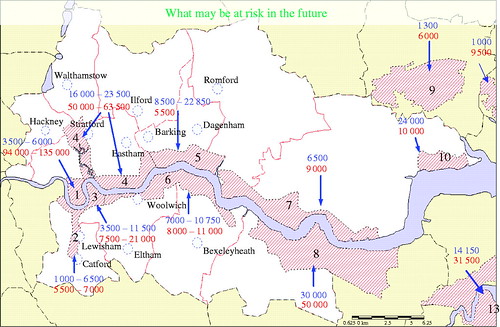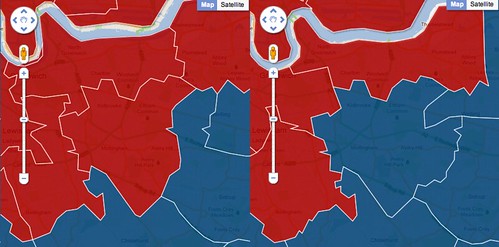
Thames Gateway regeneration area; zones of change:
(1) Isle of dogs, (2) Greenwich, Deptford and Lewisham, (3) Greenwich Peninsula, (4) Stratford, Leaside and Royals (impact on Hackney Wick and Layton Goodsyard), (5) London Riverside (Banking and Havering riverside), (6) Charlton and Crayford (Woolwich, Belvedere and Erith), (7) Thurrock, (8) Ebbsfleet/North Kent, (9) Basildon, (10) Shellhaven.
New homes (blue) and new jobs (red), 2001–2016 and beyond.
(Copied from Flood risk management in the Thames Estuary: looking ahead 100 years)
‘In the summer of 1979, Margaret Thatcher’s Environment Secretary, Michael Heseltine, flew over the docks in a helicopter and famously said: “Nothing’s happening – something must be done”, and he wasn’t talking about Buckinghamshire.
As part of London Open House weekend, I joined the audience on a civil engineering boat tour sailing downstream from The Dome to Tilbury/Gravesend and back on a catamaran from the Thames Clipper fleet. It was essentially a guided tour of the past, present and future of the Thames Gateway, featuring a great deal of expertise, and at times what felt like a great deal of brainwash.
The tour was kicked off by Woolwich M.P. Nick Raynsford who gave a lively introduction in which he said the most important thing about the Millennium Dome was that it introduced the tube to this part of London, paving the way for current developments on the Peninsula. He also suggested that the lack of tube access to Canary Wharf necessitated Crossrail. He then stressed the importance of sustainable development, smirking whilst recounting that as a GMV resident, his ‘cold quarter’ energy bill was only £95, an important factor in reducing CO2 pollution. He finished off by raising the not uncontroversial issue of how to handle all the waste water produced by London’s growing population and rainfall, now it’s finally outgrowing Sir Joseph Bazalgette’s Victorian sewerage system.
He then handed over to the panel of experts: Jean Venables, an experienced civil engineer with an encyclopaedic knowledge of the Thames in relation to pollution and flooding; The Chief Executive of the London Thames Gateway London Partnership; and a Civil Engineering specialist on Waste Management.
Jean Venables is a distinguished engineer who described her work on the river as “extremely satisfying.” She began by drawing our attention to the rushes around the dome, which she was involved in planting, indicating that they made excellent flood defences as they also give habitat to the species now moving into the cleaner river. Afterwards she talked about her career processing waste at Crossness, re-oxygenating the Thames when the sewers outflow into the river (she still advises against swimming in the river by the way), and then concentrated largely on her involvement in flood protection. In a discussion about the Thames Barrier and the 35 other major floodgates, 400 minor ones, and 337?km of tidal walls, she pointed out that the Barriers have been closed “in anger” over 100 times since 1983, adding that the newspapers are reluctant to report the saviour of London. She also explained why flooding happens by comparing low pressure over the atlantic to someone drinking through a straw – apparently the ocean rises by 3-5 inches, flooding tidal rivers as a result. Furthermore the lower half of Britain is actually sinking, whilst Scotland is raising up, in a process that will continue to around 2030, at which point the Thames Barrier is set to become incapable of protecting the city any longer. This means that the coming development of 226,000 houses along the riverside should also include new flood defences along the Thames and its tributaries.
The Chief Executive of the Thames Gateway Partnership set the scene for her talk by invoking Michael Heseltine’s famous reimagining of the eastern Thames region from the point of view of a helicopter…despite that fact that we were actually on a boat. She then proceeded to use Raynsford’s earlier comments on the importance of transport to launch into familiar old arguments used by the Eastern London Road Lobby. Showing a startling lack of sensitivity, she expressed open disdain for the Londoners who’ve repeatedly beaten bridge and motorway building schemes in South East London. The all too familiar brainwash took in the usual arguments: lack of crossings between Blackwall and Dartford (er, apart from the Woolwich Ferry, the Thames Clippers, the foot tunnels, the DLR, and the coming cable car and Crossrail routes you mean?); and the old “Do you get stuck in Blackwall Tunnel” mantra (er no actually, I check londontraffic.org or catch the DLR or a Thames Clipper, thanks)… To make matters worse, she revisited this argument as the boat reached Dartford later on, complaining that the logistics of building bridges at such a wide point of the river mean that we really would be better off building one upstream (a further crossing at Dartford is currently being considered as an option I believe). In a rather anxious moment, I formed the impression that the classic Gallions Reach or Silvertown motorway bridge plans are still upmost in the minds of the developers – when will these planners acknowledge that a comprehensive public transport system is the most sustainable way forward, surely there’s a lobby for that too? Ho Hum. She also suggested that we would be wise to buy properties in the Woolwich Arsenal in readiness for the Crossrail property bubble, adding insult to injury by apparently conflating development with gentrification – oh…my…gosh. In keeping with the apparent lack of balance, social housing never once got a mention. To make matters even worse, she added that she’d not been paid to promote the Arsenal developments – which aroused suspicions as to what she might have been paid to say, hence the concerns about road lobbying and one sided brainwash. Despite giving an apparently unbalanced speech, she did occasionally refrain from bigging up big builders to impart some genuine wisdom: introducing us to the RSPB headquarters, and responding to a complaint about the Dartford Toll by explaining that historically, most London Bridges were tolled, but due to their advanced age, toll expiration had occurred a long time ago (As you may know however, the Dartford toll was due to expire, but was retained instead and is now due to go up to £2.50).
The waste expert was able to demonstrate some sensitivity towards local concerns, acknowledging the controversies that led to a 15 year planning application process to get the Waste Incinerator built in Belvedere. This is a new building, just east of the Beautiful Sludge Incinerator. He also pointed out the Yellow containers on barges sometimes seen on the Thames are waste carriers, many now bound for Belvedere. The boat then passed a hot air waste processing plant on the northern bank (beside Ford Dagenham), and then Frog Island, London’s old landfill site, so at least the Belvedere incinerator is in similar company. The panel went to some pains to sell incineration technology to the audience, bearing in mind that whilst incineration is possibly a sustainable method, these plants are routinely denied planning permission due to local opposition on air quality grounds, seeing opposition from the likes of George Osborne and Eric Pickles, at least in their own back yards.
All in all, it was a fascinating if at times troubling boat tour, and now that the surprisingly beautiful interior of Woolwich Gala Bingo is closed off, and the Severndroog preservation trust are concentrating on opening up permanently, I would strongly recommend the trip as a local attraction if it runs next open house weekend.

